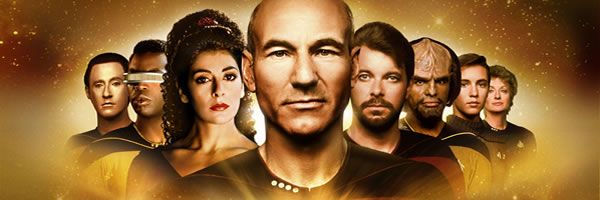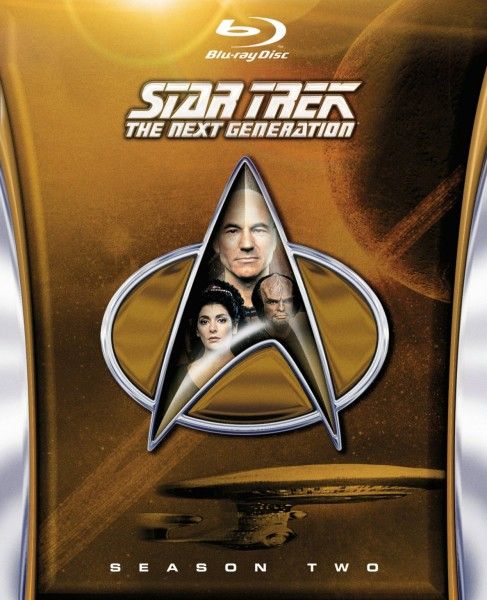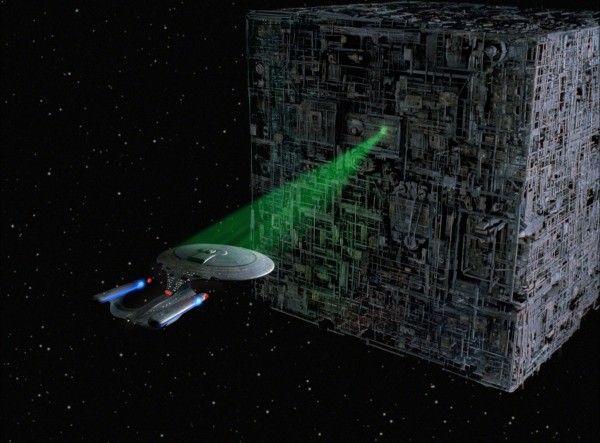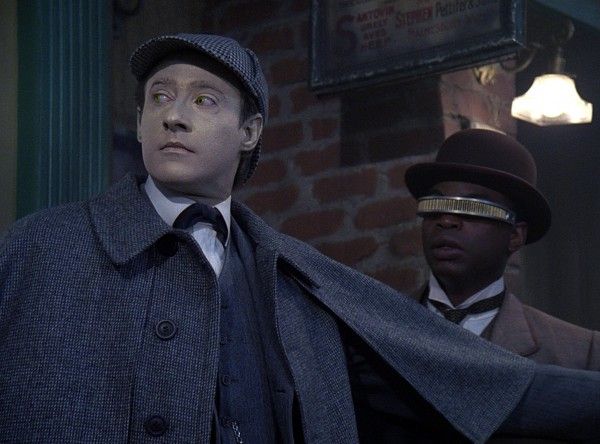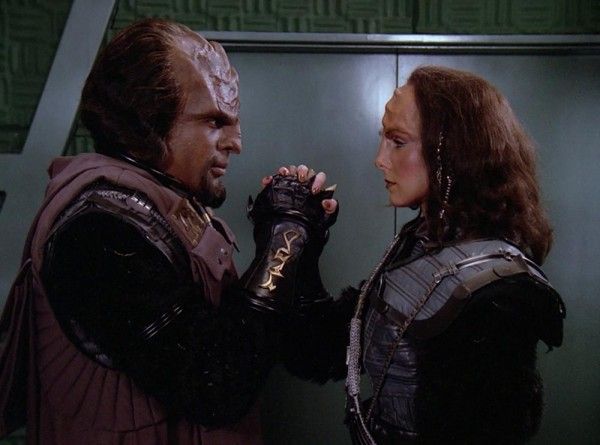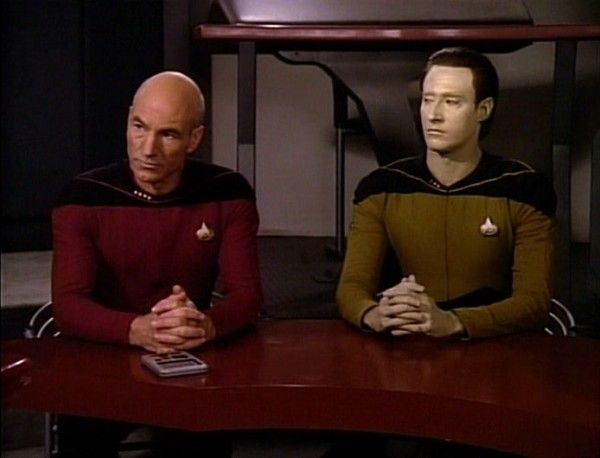“Another man would have been humiliated to say those words,” Q (John De Lancie) grudgingly concedes to Jean-Luc Picard (Patrick Stewart). “Another man would have rather died than ask for help.” He’s speaking at the end of “Q Who” after Picard has swallowed his pride and asked for aid during the first fateful encounter with the Borg. It’s not hard to figure out who Q meant by “another man.” Faced with the same scenario, James T. Kirk would have gone down guns blazing… and likely doomed the universe as a result. Picard is most assuredly not Kirk; in that moment, The Next Generation stepped decisively out of the original Star Trek’s shadow to stand beside it as an equal. Hit the jump for my full review.
The show’s second season definitely saw its share of bumps, but it also marked its coming of age. The writing improved dramatically from the spotty first season, and the characters fit into their assigned roles with much more confidence. Riker (Jonathan Frakes) grew a beard. Wesley (Wil Wheaton) stopped whining. Whoopi Goldberg showed up, the Klingons got cooler, and we finally saw a new alien race that legitimately scared the crap out of us. If the first season was a hiccup, this one was a full-throated roar: showing us exactly what this show was capable of.
It wasn’t always easy. For starters, the cast lost a key player in Gates McFadden, who played Dr. Beverly Crusher and was sacked for complaining about sexism in some of the scripts. Her replacement, Diana Muldaur, had the deck stacked against her from the beginning. Her chemistry couldn’t quite gel with the rest of the cast, and the fans despised her despite her solid and reliable work. (Even so, McFadden’s return in Season Three came as a great relief.)
A second blow against them came with the 1988 writers’ strike, which hamstrung creator Gene Roddenberry’s ability to find decent screenwriters. He responded by cannibalizing scripts from the aborted Star Trek: Phase II series from the 70s; even so, the number of episodes dropped this season and they had to resort to an abyssmal clip show for the finale.
Yet despite those obstacles, The Next Generation grew by leaps and bounds in their second year. Since the show was syndicated, there was no network interference, and Roddenberry had an iron-clad commitment to multiple seasons from Paramount. He took bold advantage of it, with complex story arcs that really delved into Star Trek’s larger philosophical questions. Unlike the original Trek, which tended to center around Kirk, TNG firmly embraced the idea of an ensemble. We thus saw episodes focused totally on Worf (Michael Dorn) or Geordi (LeVar Burton), for example, attaining a solid balance between the characters and allowing the writers to shift gears whenever they found a strong vein.
Spiner benefited most from the trend. Data already ranked among the show’s most popular characters, but his efforts here elevated him to an entirely new level. The most telling example came in “The Measure of a Man,” which put the character on trial to decide whether – as a machine – he had any rights. It stands as a high point not just of this season, but Star Trek in general, thanks to Spiner’s adroit understanding of his role and one of the best speeches Stewart ever delivered. Only slightly less impressive was “Elementary, My Dear Data,” which put the android in Sherlock Holmes’ shoes and transformed the holodeck from a one-note gimmick into a fulcrum for legitimate drama.
In addition to the standing cast members, the writers made a feast out of the cameos and stand-alones. Goldberg’s appearance as the Yoda-esque Guinan could have spelled disaster, with a big star demanding more and more screen time (as well as essentially duplicating Counselor Troi’s role). Instead, she melded effortlessly into the company and appeared only when her character had a legitimate role to play. Less prominent, but no less effective was the unknown Suzie Plakson, playing Worf’s ex-lover K’Ehlar. She brought wit and humor to a potentially stodgy part, while helping Dorn find new sides to Worf. Suddenly, he stopped being “the Klingon” and became someone with a past, a personality, and even a few regrets.
And of course, there was De Lancie’s Q, an instant highlight reel whose verbal spars with Picard gave both actors plenty of meat to sink their teeth into. With Q came the Borg, and there more than anywhere else, the second season earned its spurs. Having dropped the ball on the Ferengi in Season One, the producers needed something much more menacing to challenge our heroes. (As an aside, I should mention that I quite love the Ferengi as long as they’re acting like intergalactic used car salesmen. I’m just not scared of them.) The Borg took their cues from George A. Romero’s zombie flicks, armed with high-tech weapons and eager to “assimilate” individuals into their hive mind. They resembled nothing we’d ever seen on Trek before; even the mighty Klingons started to look like bush leaguers in comparison.
That kind of material became the norm rather than the exception in Season Two. The dialogue grew sharper, and the stories more intellectually rigorous. As the season evolved, TNG changed from something you watched when nothing else was on to something you carved out time for every week. It was a joy to behold, and with the exception of some silly haircuts, the show holds up amazingly well. The early CG special effects are still clunky, but also distinctive: as much at home in the show as the uniforms, and a further sign that TNG had officially become its own animal.
The Blu-ray collection delivering it to us adheres to a high standard, though the extra features take some hunting. The five-disc set does a fine job with the episodes themselves: all spruced up and looking their best for the new format. In addition, “The Measure of the Man” receives an extended cut, and both it and “Q Who” feature insightful commentary from official Trek experts Michael and Denise Okuda (as well as the directors and screenwriters).
The straight-up extras are scattered across all five discs, which means a bit of a search if you’re looking for something in particular. The fifth disc holds the meat: a pair of 40-minute documentaries covering the challenges of the second season (including some surprisingly candid discussions of McFadden’s departure), and a wonderful hour-long 25th anniversary reunion with the entire cast. Their mutual affection for each other resonates very deeply here. Stewart comes close to tears at times, and Dorn hits him with some zingers the way (one suspects) only a family member has permission to do. The feature further demonstrates the actors’ chemistry with each other… a big reason why the show worked as well as it did. (A brief “Mission Log” covering the new developments of Season Two completes the fifth disc.)
The remaining four discs each have handful of short docs, in which the cast reminisces about their characters and favorite episodes, the producers talk about developing the Borg and other new elements, and Trek archivist Penny Juday discusses her job. The high point is a Trek-themed segment of Burton’s Reading Rainbow, introduced by the actor himself.
The features offer few complaints, though a little more on the Borg would have been welcomed and we could have used a more unified menu to help find them all. Trekkies need no urging to pick up the set, of course, but newcomers wondering what all the fuss is about could do a lot worse than checking out the episodes here. Things were never the same after Season Two, when TNG grew up, and the Enterprise-D truly entered uncharted territory. The Blu-ray collection meets the fans’ sky-high expectations: showcasing the moment when the show went from not-bad to unspeakably awesome.

